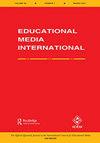Immersive virtual reality as an action: measuring approach and learning status of learners after planning myVOR
IF 1.4
Q2 EDUCATION & EDUCATIONAL RESEARCH
引用次数: 3
Abstract
ABSTRACT This research investigates the learning progress and bottlenecks of students during learning via an immersive virtual reality environment. At the planning stage of this action research, an immersive virtual reality learning environment – myVOR- was designed and developed to teach concepts and procedures. myVOR was developed using the Unity game engine. Depth-camera integrated Head Mounted Display was used to support the skill training of learners via intuitive gesture interaction. In the action stage, myVOR was applied to fourteen 3rd year nursing students, once a week for a month. Qualitative and quantitative data were gathered to analyse learning status and, the fluctuation among sessions concerning behaviours, attitudes, reactions. Data were collected from video recordings, myVOR logs, interviews, and an information exam. The results indicated that myVOR was sufficient to teach concepts and complex procedures. However, the learners experienced problems before adapting the used technology, and this affected their behaviours and attitudes during training. The findings of this research support the requirement for a comprehensive needs analysis before designing immersive virtual reality learning environments.沉浸式虚拟现实作为一种行动:规划myVOR后学习者的测量方法和学习状态
本研究通过沉浸式虚拟现实环境考察学生在学习过程中的学习进度和瓶颈。在本次行动研究的策划阶段,设计并开发了一个沉浸式虚拟现实学习环境——myVOR——来教授概念和程序。myVOR是使用Unity游戏引擎开发的。使用深度摄像头集成头戴式显示器,通过直观的手势交互来支持学习者的技能训练。在行动阶段,将myVOR应用于14名三年级护生,每周一次,持续一个月。收集了定性和定量数据,以分析学习状况以及有关行为、态度和反应的课程之间的波动。数据收集自录像、myVOR日志、访谈和信息考试。结果表明,myVOR足以教授概念和复杂的程序。然而,学习者在适应所使用的技术之前遇到了一些问题,这影响了他们在培训期间的行为和态度。本研究结果支持在设计沉浸式虚拟现实学习环境之前进行全面需求分析的需求。
本文章由计算机程序翻译,如有差异,请以英文原文为准。
求助全文
约1分钟内获得全文
求助全文
来源期刊

Educational Media International
EDUCATION & EDUCATIONAL RESEARCH-
CiteScore
3.20
自引率
0.00%
发文量
10
 求助内容:
求助内容: 应助结果提醒方式:
应助结果提醒方式:


